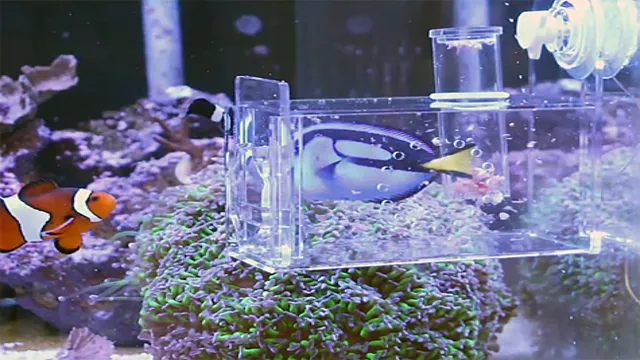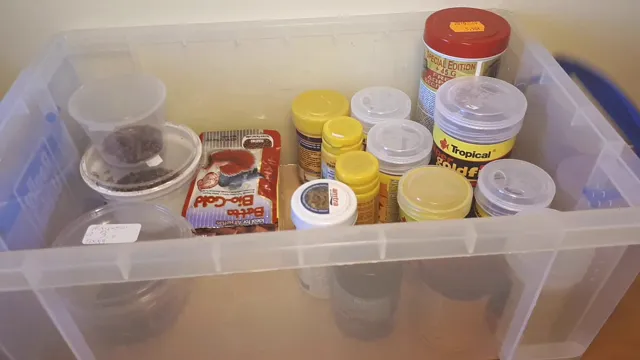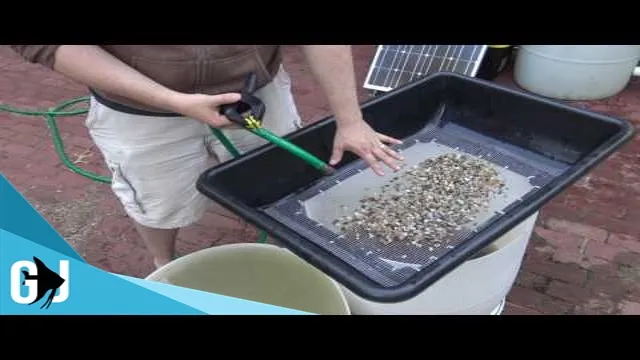Have you ever dreamed of having your own marine aquarium filled with vibrant and fascinating fish species? If so, you’re not alone! But catching marine aquarium fish can be a challenging task, even for experienced aquarists. There are many factors to consider, such as the type of fish you want to catch, the equipment required, and the best techniques to use. Don’t worry though, because this guide will provide you with all the essential information you need to catch your own stunning marine aquarium fish.
Firstly, it’s important to choose the right type of fish for your aquarium. Factors such as the size of your tank and the other species you already have should be taken into account. Research the behavior and compatibility of each fish species to ensure they can happily live together.
Once you have chosen your fish, you will need to obtain the necessary equipment, such as a sturdy net, a reservoir for holding the fish, and any required chemicals or treatments. The actual process of catching the fish can be tricky, and it’s crucial to avoid harming them. One effective technique is to use a trap baited with food, placed in the water near where the fish congregate.
Another option is to use a net with small holes to minimize the risk of injury to the fish. Ensure you handle the fish gently and transfer them into the reservoir as soon as possible. However, catching marine aquarium fish isn’t always just about physical techniques.
It also requires patience and persistence. Sometimes, catching a particular species may take multiple attempts, and it’s important not to get discouraged. Just like fishing in the wild, catching marine aquarium fish requires a combination of skill, preparation, and luck.
However, with the right tools and techniques, the rewards of having your own stunning aquarium filled with eye-catching fish species, make the challenge well worth it. In conclusion, catching marine aquarium fish can be a fun and rewarding experience, but also a challenging one. It’s important to select the right species for your aquarium, obtain the necessary equipment, and use effective and humane techniques to catch and transfer the fish safely.
Understanding Your Fish’s Behavior
If you’re wondering how to catch marine aquarium fish, the key is understanding their behavior. Different species of fish have unique habits and preferences, so it’s essential to conduct research on your desired catch. For example, some fish prefer living in schools, while others prefer to be solitary.
Some fish are active during the day, while others are active at night. Additionally, factors such as water temperature, pH levels, and tankmates can also affect a fish’s behavior. By observing your fish, you can also pick up on individual habits, such as feeding times and preferred hiding spots, making it easier to catch them.
Just remember to be patient and gentle when catching your fish, allowing them to acclimate to their new environment slowly. With a bit of knowledge and patience, you’ll be able to catch and care for your aquarium fish successfully!
Identifying the Type of Fish
As fish owners, it’s essential to understand the behavior of our aquatic pets. Each fish species has its own unique personality, and recognizing your fish’s behavior can help you identify its type and tailor its care accordingly. Some fish may be more active than others or prefer to stay in one spot.
Observing their feeding habits, tank mates, and swimming patterns can all provide valuable insight. For example, if you notice that your fish likes to hide in plants or decorations, it may be a species that thrives in a more natural or heavily planted environment. Additionally, different types of fish may exhibit specific behaviors, such as schooling or aggression.
By paying close attention to your fish and its actions, you’ll have a better understanding of its needs and ensure a happy and healthy life for your aquatic friend.

Learning About Their Habitat
Understanding Your Fish’s Behavior As a fish owner, it’s essential to understand your fish’s behavior to ensure their happiness and well-being. One of the first things you should do is learn about your fish’s natural habitat and what type of environment they are accustomed to living in. For example, some fish are native to freshwater while others thrive in saltwater, and these differences can significantly impact their behavior.
Additionally, fish may prefer certain water conditions, such as pH levels, water flow, and lighting, that are specific to their natural habitat. By replicating these environmental conditions as closely as possible within your aquarium, you can create a more comfortable environment for your fish and reduce the likelihood of health issues. You can also recreate their habitat using appropriate decorations that match their natural environment. (See Also: How to Check Aquarium Temperature Without Thermometer: 5 Simple Methods)
Overall, by understanding your fish’s behavior and their natural habitat, you can create a more enjoyable and healthy living environment for them.
Selecting the Right Equipment
When it comes to catching marine aquarium fish, selecting the right equipment is crucial. The right gear not only ensures a successful catch but also keeps the fish alive and healthy. Firstly, you need a high-quality net that is suitable for the fish you are catching and the size of your tank.
A small mesh is appropriate for small fish, whereas larger fish require a net with bigger holes. Secondly, having a good set of gloves is essential, as it protects both you and the fish from harm. Additionally, a quarantine tank is necessary for new fish to ensure they are healthy before introducing them to your main aquarium.
It’s also important to invest in a high-quality water test kit as maintaining proper water parameters is critical for the health of your fish. Lastly, consider purchasing a fish trap if you have trouble catching elusive fish. Overall, investing in the right equipment will make the process of catching and keeping marine aquarium fish more manageable and rewarding.
Choosing the Right Net
Choosing the right net for your sport is crucial to ensure fair play and safety. The equipment should match the requirements of the game and the skill level of the players. Different nets come in various sizes, materials, and designs.
For example, volleyball nets are typically 32 feet long and 39 inches wide, made of nylon or polyethylene mesh, and feature a boundary line that separates the court from out-of-bounds areas. Basketball nets, on the other hand, are rectangular and can vary in size, but the rim diameter is usually 18 inches, and the net is made of nylon or polyester. It’s essential to select the right net size, tension, and height to prevent injuries and provide a level playing field.
Moreover, regular maintenance and proper storage can extend the lifespan of the net and enhance its performance. Overall, choosing the right net is a crucial step in preparing for any sports competition, and it requires careful consideration of various factors to ensure the best possible outcomes.
Using a Good Quality Trap
When it comes to selecting a trap for your pest problem, it is crucial to choose the right equipment to get the job done effectively. Look for traps that are made of good quality materials that can withstand harsh weather conditions and heavy use. Consider the type of pest you need to trap and choose a trap that is specifically designed to target that species.
For example, if you are dealing with rodents such as rats or mice, choose a trap that is large enough to accommodate their size and has a strong, spring-loaded mechanism to ensure a quick and humane kill. If you are dealing with flying insects, choose a trap that uses a sticky glue to keep them in place. Using a good quality trap is essential for successful pest control and will save you time and money in the long run.
So, take the time to choose the right equipment for your pest problem and enjoy a pest-free environment.
Using a Fish Hook
When it comes to fishing, selecting the right equipment is crucial, especially when choosing the right hook. A fish hook is a small but mighty tool that can determine whether or not you have a successful fishing trip. Choosing the right size and shape of the hook for the type of fish you are targeting is essential.
You don’t want a hook that is too small or too big for the fish you are trying to catch. The hook should be strong enough to withstand the weight of the fish and not break under pressure. You can choose from a variety of hooks, including J-hooks, circle hooks, offset hooks, and treble hooks. (See Also: How Thick of Glass Should I Use for An Aquarium: A Complete Guide)
Make sure to do some research on the fish species you are targeting, and choose the hook accordingly. By selecting the right hook, your chances of catching that prize fish will increase significantly.
Catching the Fish
When it comes to starting your own marine aquarium, one of the biggest challenges is catching the fish and other creatures that you want to populate it with. However, with a little bit of patience, preparation, and the right tools, it can be a simple process. Before you even start trying to catch any fish, it’s important to make sure that you have the right equipment on hand.
This includes a large net, preferably one that has a long handle so that you can reach all corners of the tank, as well as a container that you can use to transport the fish once you’ve caught them. Once you have your equipment ready, it’s time to start catching. The first step is to observe the fish and their behavior, so that you can plan your approach and choose the best time to catch them.
Once you’ve determined the right moment, gently scoop the net under the fish and slowly lift it out of the water. Be sure to move slowly and carefully to avoid stressing the fish out or damaging its body. With some patience and a little bit of finesse, you’ll be able to catch the fish you want to add to your tank in no time.
Timing is Key
Timing is key when it comes to catching fish. Understanding the right time to cast your line can make all the difference in your success on the water. Factors like weather patterns, water temperature, and the behavior of the fish can all play a role in when the best time to fish is.
For example, during the summer months, many fish tend to become more active during the early morning and late afternoon when the water is cooler. On the other hand, during the winter months, midday fishing can be more productive as the fish tend to move to deeper waters during the colder hours of the day. It’s important to do your research and understand the specific habits of the fish you are targeting in order to maximize your chances of success.
With the right timing and a bit of patience, you’ll be reeling in catch after catch in no time.
Using Bait Effectively
When it comes to fishing, using bait effectively can make all the difference in catching the fish. Whether you’re a beginner or an experienced angler, choosing the right bait is crucial to attract your target species. Researching the type of fish you’re hoping to catch and understanding their feeding patterns can be helpful in selecting the best bait.
Using live bait such as worms, minnows, or shrimp are often the go-to for many anglers, while others prefer artificial lures such as crankbaits, spinnerbaits, or jigs. It’s important to experiment and try different types of bait until you find what works best for you in the specific body of water you’re fishing in. With patience and persistence, using the right bait can increase your chances of catching the fish of your dreams.
Tips for Success
Catching marine aquarium fish can be a challenging endeavor but with the right tips, it can be a success. Firstly, it’s important to research and understand the specific breeds of fish you plan to catch. This includes their behavior, preferences, and habits.
Additionally, ensuring that your equipment is suitable and reliable is crucial. Poor equipment can make the process more frustrating and less efficient. Using the right bait is also paramount to attracting the desired species.
Furthermore, patience is a virtue when catching marine aquarium fish. Unlike freshwater species, these fish require a slower and more strategic approach. Lastly, be sure to check local regulations and laws for size and quantity limits to ensure you’re not exceeding any limits.
By following these tips, you will have a higher chance of success in catching marine aquarium fish and creating a beautiful and thriving aquatic ecosystem in your home. (See Also: How to Make Aquarium Stand Taller: Simple Steps to Elevate Your Aquatic Display!)
Conclusion
In conclusion, catching marine aquarium fish requires the perfect combination of patience, skill, and a bit of luck. It’s like fishing, but with the added challenge of keeping the fish alive and healthy in your tank. The key is to research your target species, have the proper equipment, and be prepared to adapt to changing conditions.
And of course, don’t forget the most important ingredient – a dash of determination and a sprinkle of humor. Happy fishing!”
FAQs
What are the best baits to use when catching marine aquarium fish?
Some of the best baits to use when catching marine aquarium fish include brine shrimp, small pieces of fish or squid, and pellet feed.
How can I ensure that the fish I catch for my aquarium are healthy?
To ensure the fish you catch are healthy, make sure the water they are caught in is clean and free from pollutants, and observe the fish for any signs of disease or injury before adding them to your aquarium.
What equipment do I need to catch marine aquarium fish?
Some basic equipment you will need to catch marine aquarium fish includes a fishing rod, fishing line, hooks, and bait. Additionally, you may want to invest in a good fishing net and a fish tank with a lid to transport the fish safely.
Are there any regulations I need to follow when catching marine aquarium fish?
Yes, it is important to check with your local fishing authorities to ensure you are following all regulations and have obtained any necessary permits before catching marine aquarium fish.
How can I find good spots for catching marine aquarium fish?
Look for areas where the water is clear and there is a lot of vegetation or structures that attract fish. Additionally, talk to other aquarium owners and local fishermen for tips on where to find the best fish.
What should I do if I accidentally catch a protected or endangered species?
If you accidentally catch a protected or endangered species, it is important to release it back into the water immediately and report the sighting to your local fishing authorities.
How can I safely transport the fish I catch for my aquarium?
To safely transport the fish you catch, place them in a fish tank with a lid and add enough water to cover their gills. Avoid overcrowding the tank, and keep the tank and fish as steady as possible during transport.







